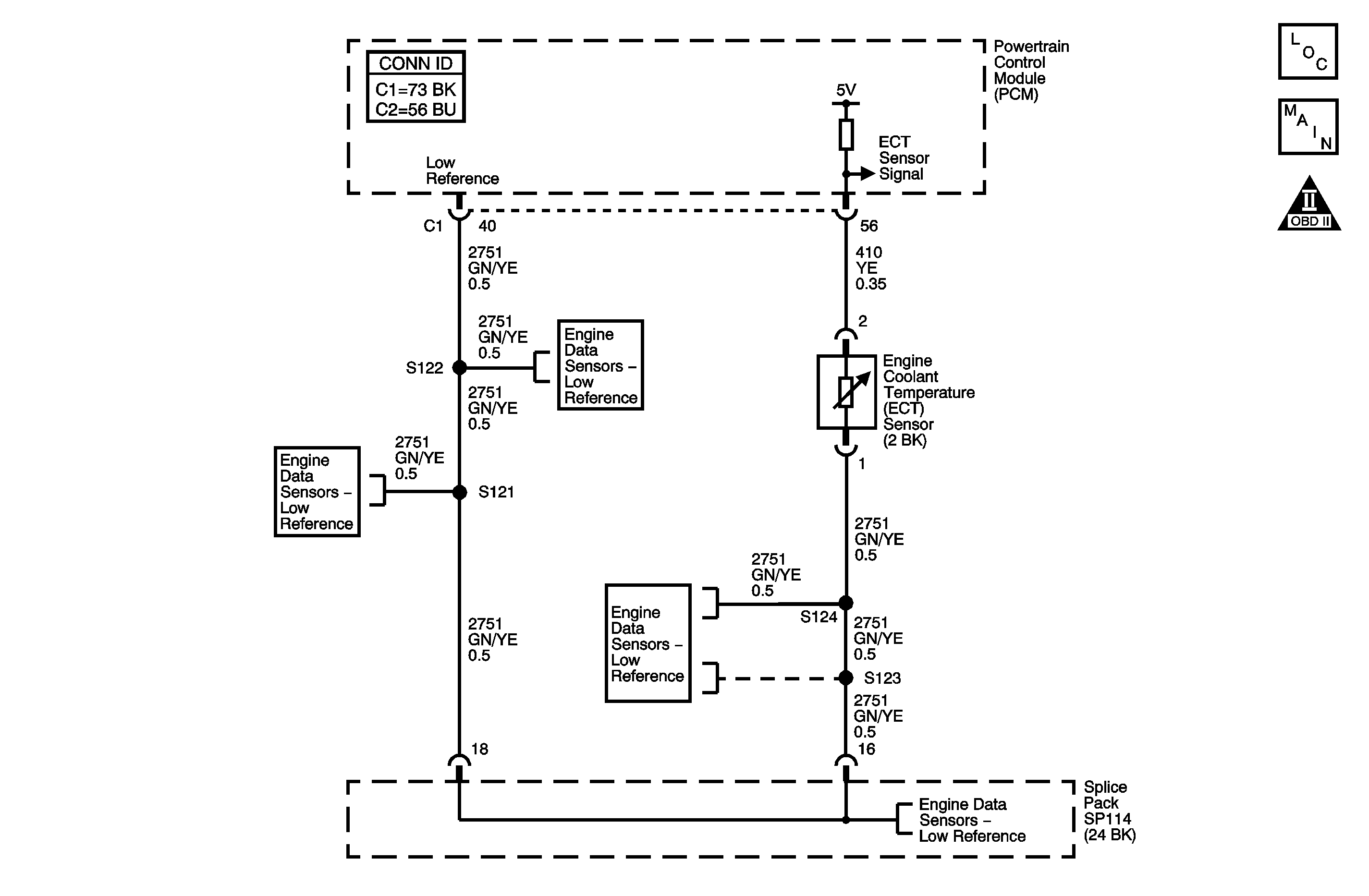
Circuit Description
The DTC P0117 Engine Coolant Temperature (ECT) Sensor Circuit Low Voltage diagnostic monitors the signal circuit value. The ECT sensor is a variable resistor that measures the temperature of the engine coolant. The powertrain control module (PCM) supplies 5 volts to the ECT signal circuit and supplies a ground to the low reference circuit. If the PCM detects a low ECT signal voltage, which is a high temperature indication, this DTC sets.
The following table illustrates the difference between temperature, resistance, and voltage:
ECT | ECT Resistance | ECT Signal Voltage |
|---|---|---|
Cold | High | High |
Warm | Low | Low |
DTC Descriptor
This diagnostic procedure supports the following DTC.
DTC P0117 Engine Coolant Temperature (ECT) Sensor Circuit Low Voltage
Conditions for Running the DTC
| • | The ignition is ON. |
| • | DTC P0118, is not set. |
| • | DTC P0117 runs continuously once the above conditions are met. |
Conditions for Setting the DTC
| • | The PCM detects that the ECT sensor signal voltage is 0.08 volts or less. |
| • | The above condition is present for at least 2 seconds. |
Action Taken When the DTC Sets
| • | The powertrain control module (PCM) illuminates the malfunction indicator lamp (MIL) when the diagnostic runs and fails. |
| • | The PCM records the operating conditions at the time the diagnostic fails. The PCM stores this information in the Freeze Frame/Failure Records. |
| • | The PCM enters the Fail Safe Function in which the coolant temperature will use default values and the fuel control system will operate in OPEN LOOP. |
Conditions for Clearing the MIL/DTC
| • | The PCM turns OFF the malfunction indicator lamp (MIL) after 3 consecutive ignition cycles that the diagnostic runs and does not fail. |
| • | A last test failed, or current DTC, clears when the diagnostic runs and does not fail. |
| • | A history DTC clears after 40 consecutive warm-up cycles, if no failures are reported by this or any other emission related diagnostic. |
| • | Use a scan tool in order to clear the MIL and the DTC. |
Diagnostic Aids
| • | An overheating condition may cause this DTC to set. |
| • | After starting the engine, the ECT should rise steadily to about 90°C (194°F) then stabilize when the thermostat opens. |
| • | Use the Temperature vs Resistance table in order to test the ECT sensor at various temperature levels in order to evaluate the possibility of a skewed sensor. A skewed sensor could result in a driveability condition. If the engine has sat overnight, the engine coolant temperature and the intake air temperature values should display within a few degrees. If the temperatures are not within 3°C (5°F), refer to Temperature Versus Resistance - Intake Air Temperature Sensor . |
| • | For an intermittent condition, refer to Intermittent Conditions . |
Test Description
The numbers below refer to the step numbers on the diagnostic table.
-
This step determines if a condition is present.
-
After replacing the PCM a new minimum throttle position and idle speed must also be established.
Step | Action | Values | Yes | No |
|---|---|---|---|---|
Connector End View Reference: Powertrain Control Module Connector End Views or Engine Controls Connector End Views | ||||
1 | Did you perform the Diagnostic System Check-Engine Controls? | -- | Go to Step 2 | |
Does the scan tool indicate that the ECT is near the specified value? | 168°C (334°F) | Go to Step 4 | Go to Step 3 | |
3 |
Does the DTC fail this ignition cycle? | -- | Go to Step 4 | Go to Diagnostic Aids |
4 |
Does the scan tool indicate that the ECT sensor temperature is less than the specified value? | -40°C (-40°F) | Go to Step 6 | Go to Step 5 |
5 |
Did you find and correct the condition? | -- | Go to Step 8 | Go to Step 7 |
6 | Replace the ECT sensor. Refer to Engine Coolant Temperature Sensor Replacement . Did you complete the replacement? | -- | Go to Step 8 | -- |
Did you complete the replacement? | -- | Go to Step 8 | -- | |
8 |
Does the DTC run and pass? | -- | Go to Step 9 | Go to Step 2 |
9 | With a scan tool, select Capture Info in order to observe the stored information. Does the scan tool display any DTCs that you have not diagnosed? | -- | System OK | |
